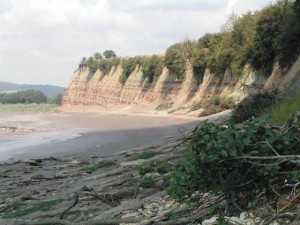
Triassic Mercia Mudstone and Penarth Group at the Garden Estuary, Westbury
Geological overview
The succession of rock units present in the river cliff are Late Triassic in age spanning both the Mercia Mudstone Group and the Penarth Group.
The red rocks that make up most of the lower part of the cliff are known as the Twyning Mudstone Formation; the overlying buff and green-grey layers belong to Blue Anchor Formation, both members of the Mercia Mudstone Group unit of rocks.
Above the Mercia Mudstone Group are the Westbury Formation and Lilstock Formation rocks, both belong to the Penarth Group unit of rocks. The former consists of dark grey to black, fossiliferous mudstones and thin sandstones with a ‘bone bed’ near the base of it containing many microfossils, bivalves, gastropods, fish and bones. The Lilstock Formation is a pale grey calcareous mudstone with a few thin siltstones and nodular, fine-grained limestones.
Collectively the rock units capture the transition of the depositional environment from a terrestrial to marine setting. The older units (Mercia Mudstone Group) are a mixture of aeolian dust, lake and sheetflood sediments deposited in an arid or semi-arid environment (evaporite minerals gypsum and halite confirm this environment). The Blue Anchor Formation is a mixture of freshwater lake and marine deposits. The overlying Penarth Group marks a change from the terrestrial environments into shallow marine shelf environments as a global sea level rise caused the low-lying area of the Worcester Basin to be inundated by the sea.
Location
Westbury on Severn, Gloucestershire; Grid Reference SO 718 128
Access
Open NOTE TIDAL so select appropriate times and dates to visit
Geological Age
Triassic – Mercia Mudstone Group; Penarth Group
Rock Types
Sedimentary – Mudstone; siltstone
Features
Variable lithologies
Fossils
Stratigraphic sequencing



